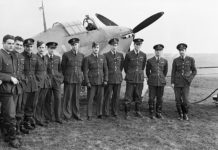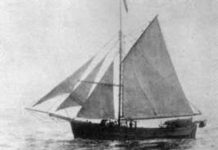Pierre Le Moyne d’Iberville displayed characteristic ruthlessness and daring in capturing and retaining three of the Hudson’s Bay Company’s trading posts.
The Hudson’s Bay Company (HBC), established on May 2,1670 by decree of the English sovereign, had been created for the purpose of wresting control of the lucrative North American trade in beaver pelts from France. To this end, HBC erected trading posts cum forts on Hudson Bay and its appendage James Bay, in close proximity to the territories that produced the most desirable pelts and to the native peoples who exchanged the pelts for European goods.
HBC thus secured a crucial logistical advantage over its French rivals, whose trading posts stood on the St. Lawrence River, hundreds of miles to the southeast. The French traders responded to the threat in 1680 by creating a new enterprise, La Compagnie du Nord, to compete for control of the fur country around Hudson Bay. In 1682, La Compagnie du Nord sent an expedition, led by the coureurs-de-bois Radisson and Groseilliers, to establish a permanent trading station on the Bay at the mouth of the Hayes River. Their success in this endeavour was undone the following year by authorities in Quebec, who confiscated Radisson’s share of the profits from the initial load of Bay pelts that he delivered. Furious and embittered, Radisson turned his coat and joined HBC. He then sailed back to Hudson Bay under English colours and took possession of the Hayes River post – and a load of 20,000 beaver pelts – for his new employers. The French toehold on the Bay was lost.
However, the growing prosperity of the HBC posts – achieved in large part by diverting trade that had previously flowed to the French posts on the St. Lawrence – could not be ignored by the leaders of New France, for it threatened their colony’s survival. As France and England were at peace – albeit uneasily – the Governor of New France, the Marquis de Denonville, could not officially order military action against the HBC posts. Instead, he unofficially sanctioned the assembling of a small army – seventy Canadian irregulars, several native guides and 30 French soldiers – by La Compagnie du Nord for an overland expedition to capture the posts. The Chevalier de Troyes, recently arrived from France, was given overall command of the force. The Canadian contingent was led by perhaps the greatest military commander Canada has produced: Pierre Le Moyne d’Iberville.
Iberville’s Background
Iberville was born in 1661, the third son of Charles Le Moyne and his wife Catherine Primot. Le Moyne had been among the original settlers of Ville Marie (present-day Montreal), gaining renown as a guide and for his exploits in defending the nascent settlement from the scourge of the Iroquois. He subsequently entered the fur trade, employing his business skills to amass considerable wealth with which he built a grand seigneury at Longueuil on the south shore of the St. Lawrence. He was also one of the founders of La Compagnie du Nord.
The young Iberville spent much of his time roaming the wilderness around the family’s seigneury, before being sent to France for training as a navigator. He subsequently received a commission in the French navy, quickly earning the reputation of a ruthless, daring and enterprising commander.
Outward Bound
The little army departed from Ville Marie in the early spring of 1686. They began the 800 mile journey on sleds, dragging 35 canoes that they would use as soon as the waterways were sufficiently clear of ice. Travelling up the Ottawa River, they passed Lake Temiscaming and Lake Abitibi, then proceeded north on the Abitibi and Moose Rivers to James Bay. Their odyssey took 82 days, and included lengthy portages through virgin forest between some of the lakes and rivers, but this overland route provided Troyes’ force with the critical element of surprise.
Capture of the HBC Posts
HBC had established three trading posts at the bottom of James Bay: Albany Fort, Moose Factory and Rupert House. Moose Factory, located equidistant between the other two, was attacked first. The post possessed formidable defenses, but they were positioned to repel attacks from the sea. Furthermore, since neither friend nor foe could reach the Bay by sea until late summer when Hudson Strait was clear of ice, few sentries were posted. In the dead of night Iberville, accompanied by his brothers Jacques de Ste. Helene and Paul de Maricourt plus several Canadian irregulars, entered the fort by scaling its walls. Once they were inside, Troyes and the balance of his force began assaulting the main gate with a battering ram. The HBC garrison of 16 men, rousted from their beds by the resulting din, raced out of their quarters to find themselves staring down the leveled muskets of Iberville and his companions. Moose Factory was captured without bloodshed.
Troyes then led his men 120 miles east to Rupert House. Employing the same tactics as at Moose Factory – a nighttime attack, with a small party gaining entry (aided on this occasion by a ladder the unwary Englishmen had left leaning against an exterior wall) to be in position when the main force assaulted the gate – they quickly captured the fort. Iberville’s role in this raid was to seize an HBC ship, the Craven, lying at anchor nearby. After leading a few men over the side of the ship, Iberville killed a sleeping sentry then stamped his feet on the deck, the customary signal to wake crews in times of emergency. The first three crewmen to emerge from the companion-way were each cracked on the head with the butt end of a musket, and the rest quickly surrendered.
Iberville then took command of the Craven for the assault on Albany Fort, the most heavily armed of the three posts, on the west side of James Bay. Troyes and Iberville had the cannons from the captured posts loaded aboard the Craven and transported across James Bay, where they were unloaded and mounted on a hill overlooking Albany Fort. From this protected position, the attackers lobbed more than one hundred cannon balls into the fort: within an hour, the stockade was in flames and the HBC defenders capitulated.
La Compagnie du Nord now controlled James Bay. HBC’s sole remaining post on Hudson Bay was York Factory, on the west coast of the Bay at the mouth of the Nelson River.
Protecting the Prizes
Shortly after capturing Albany Fort, Troyes and most of his army began the march back to Quebec. Iberville and 40 other Canadians remained to secure the captured posts and the 50,000 pelts they contained.
Iberville finally departed for Quebec in the spring of 1687, but returned later that year aboard a French frigate with orders to bring out the captured pelts. While loading furs at Albany Fort, he sighted two English warships sent be HBC to recover the post. Iberville immediately had the channel markers for the approach to the fort cut loose, causing the English ships to run aground. The crews waded ashore at a barren little island near the fort where Iberville, employing sniper fire augmented by periodic cannon balls, kept them trapped for several weeks, until scurvy and starvation forced their surrender.
He then sailed home in triumph, his ship loaded down with prisoners and furs.
Sources:
- Costain, Thomas B. The White and the Gold: The French Regime in Canada. Doubleday & Company, Inc., Garden City, New York, 1954.
- Eccles, W.J. Canada under Louis XIV. McClelland & Stewart Limited, Toronto, 1964.
- Newman, Peter C. Company of Adventurers. Penguin Books Canada, 1985.







